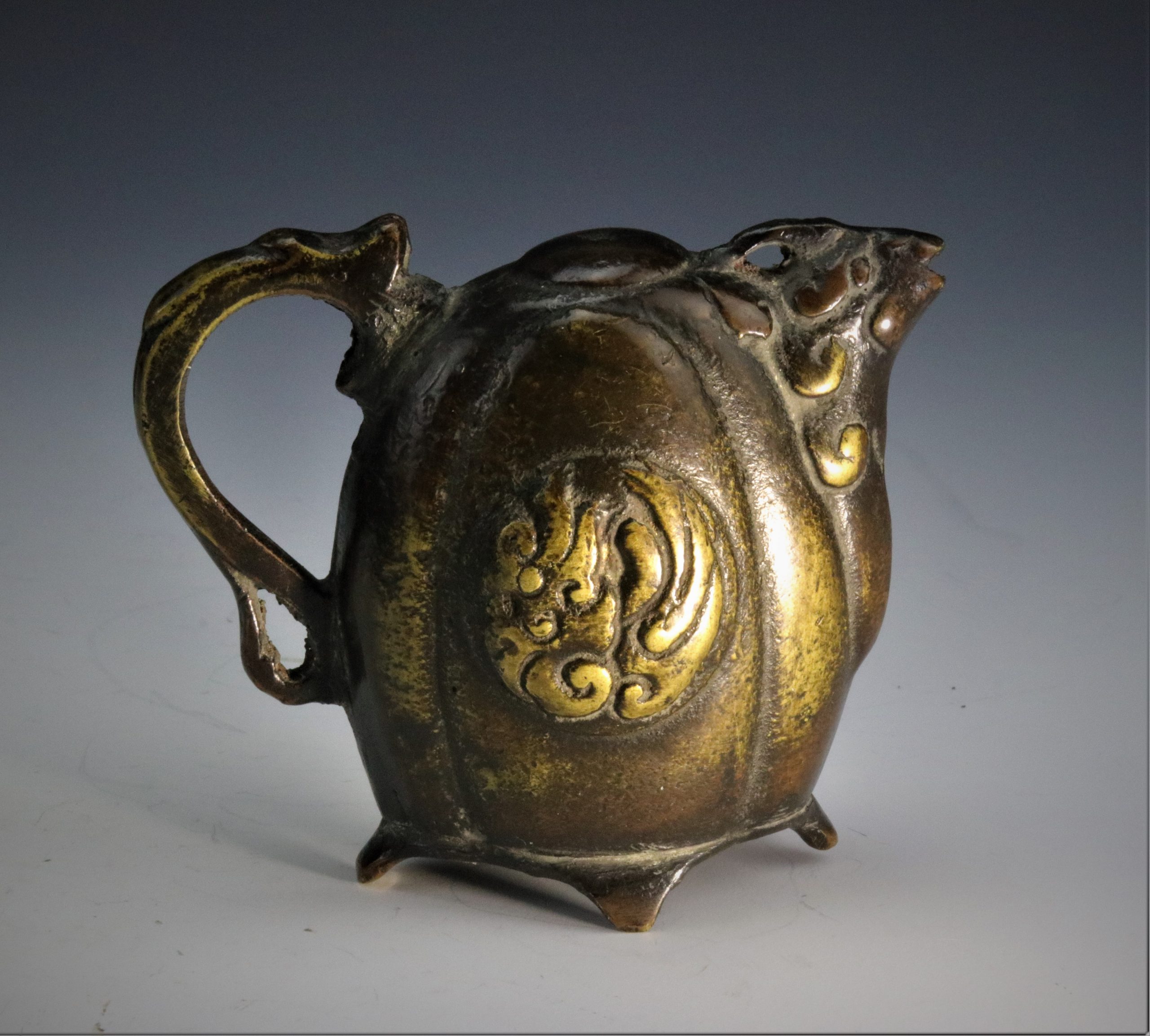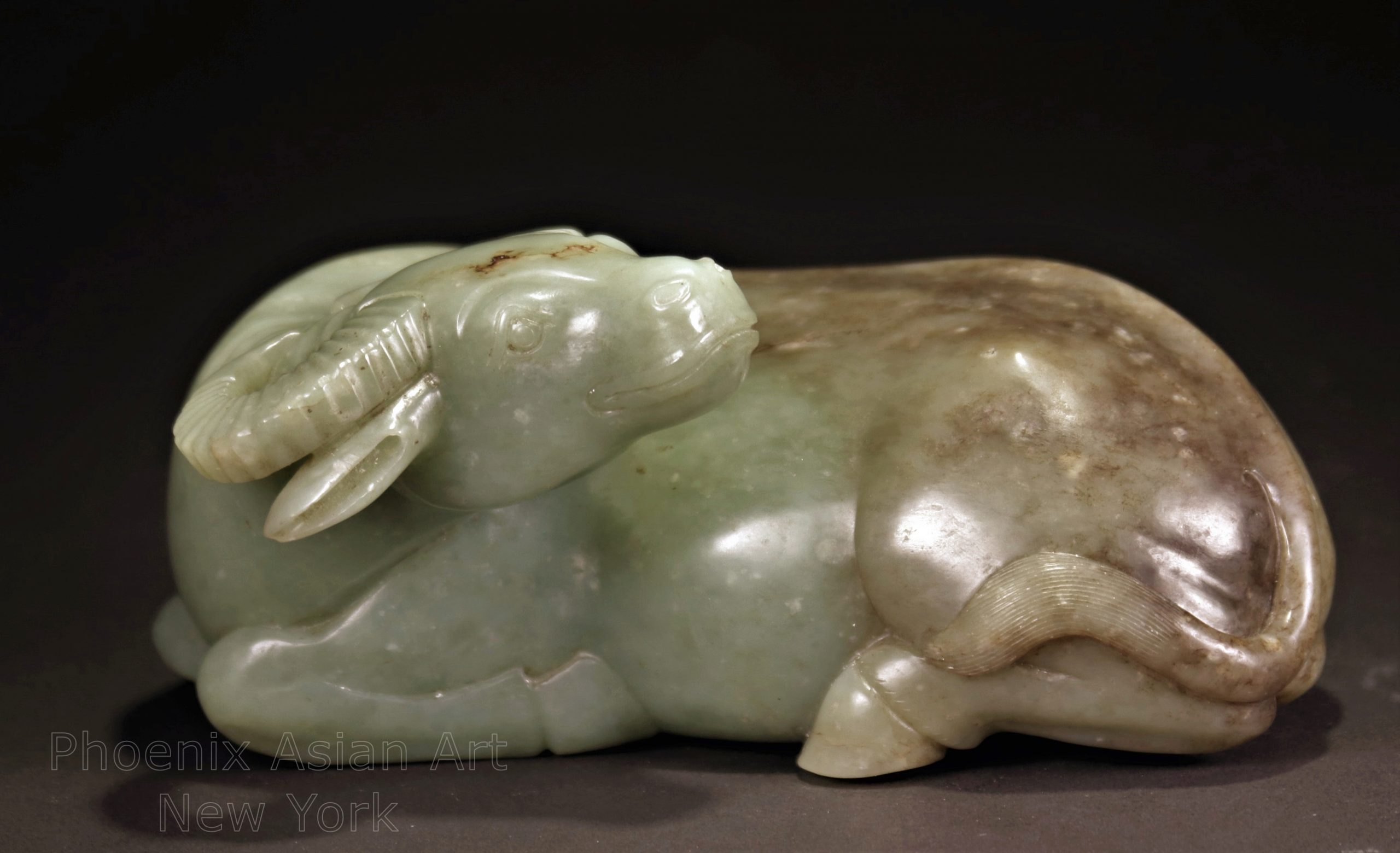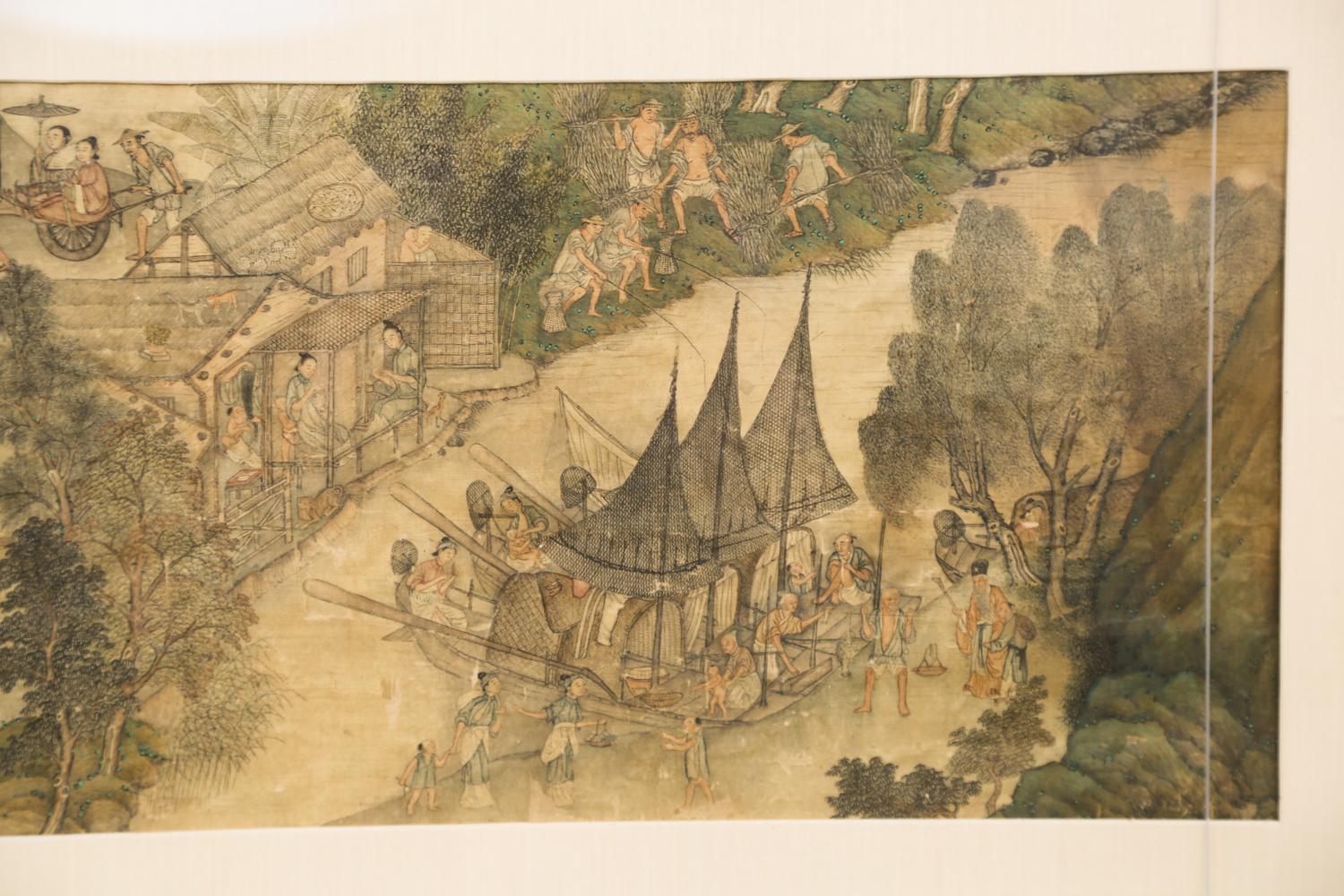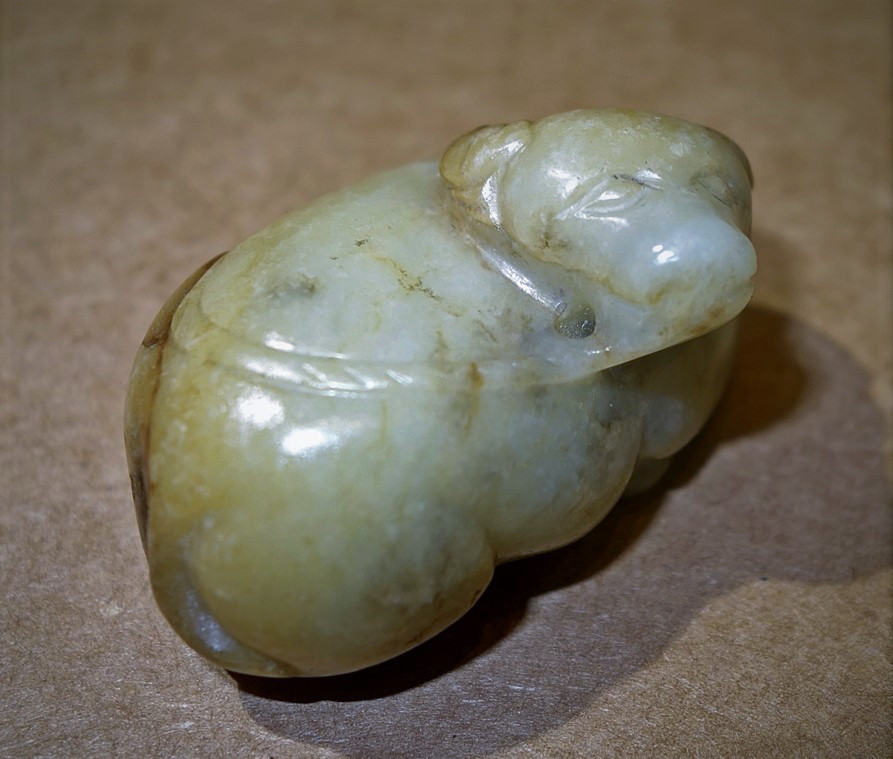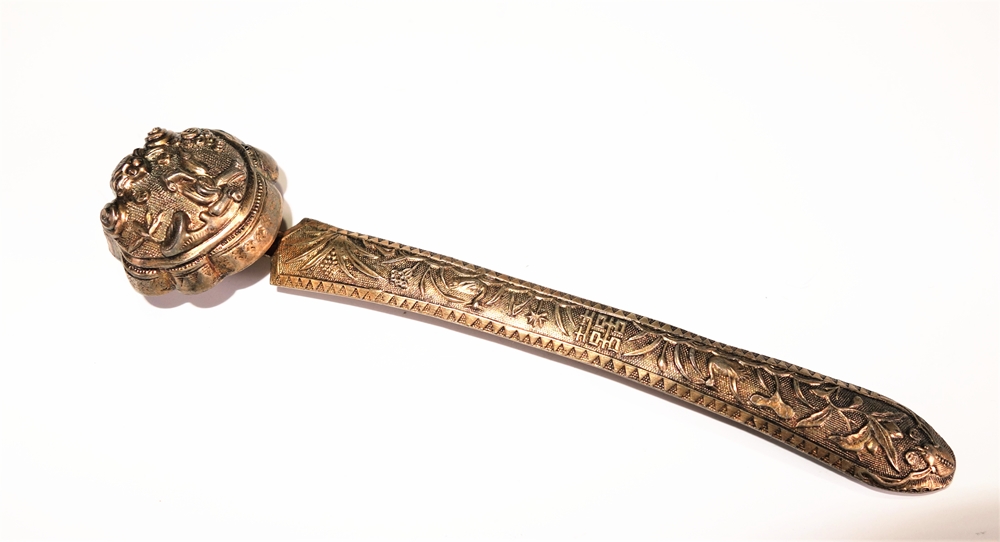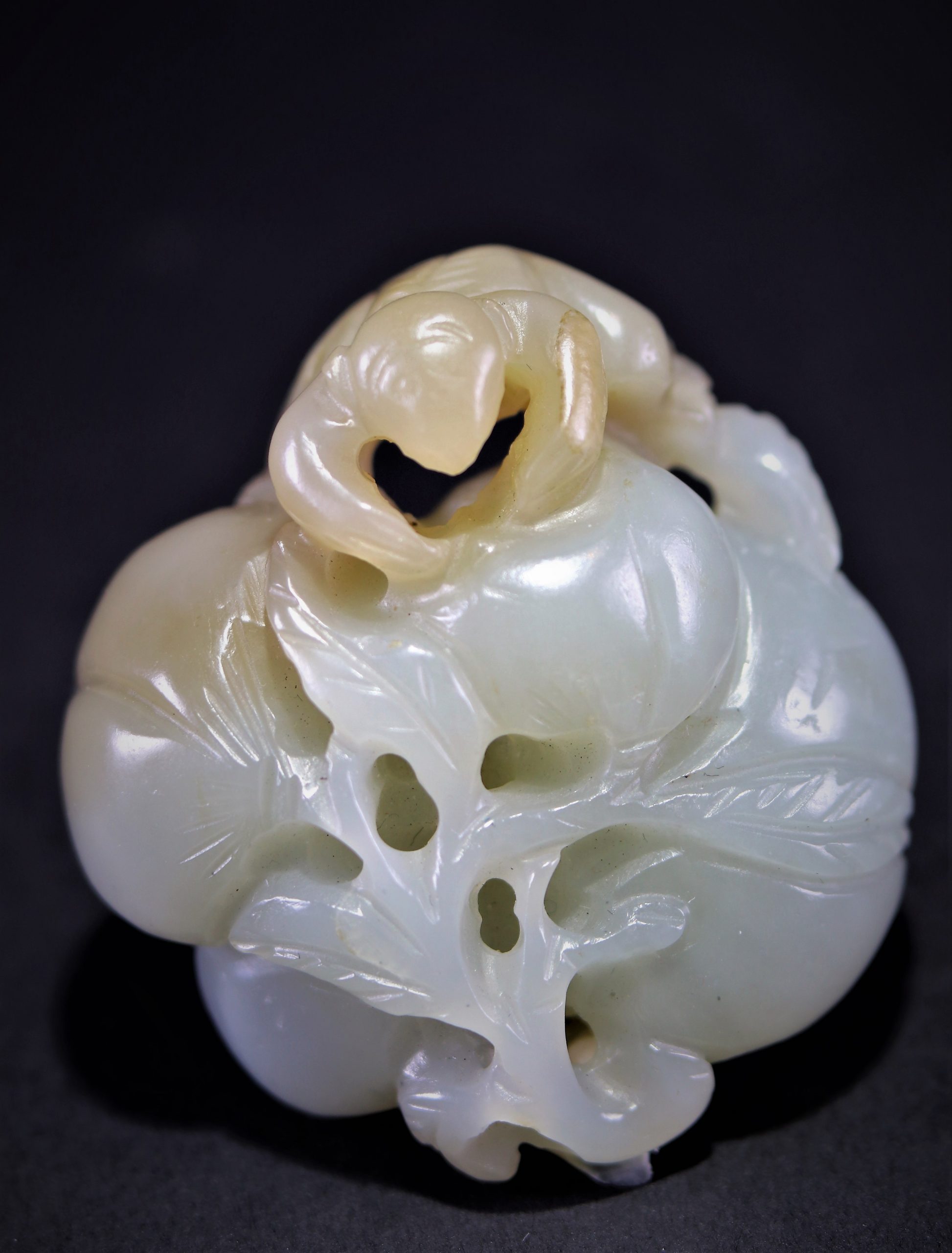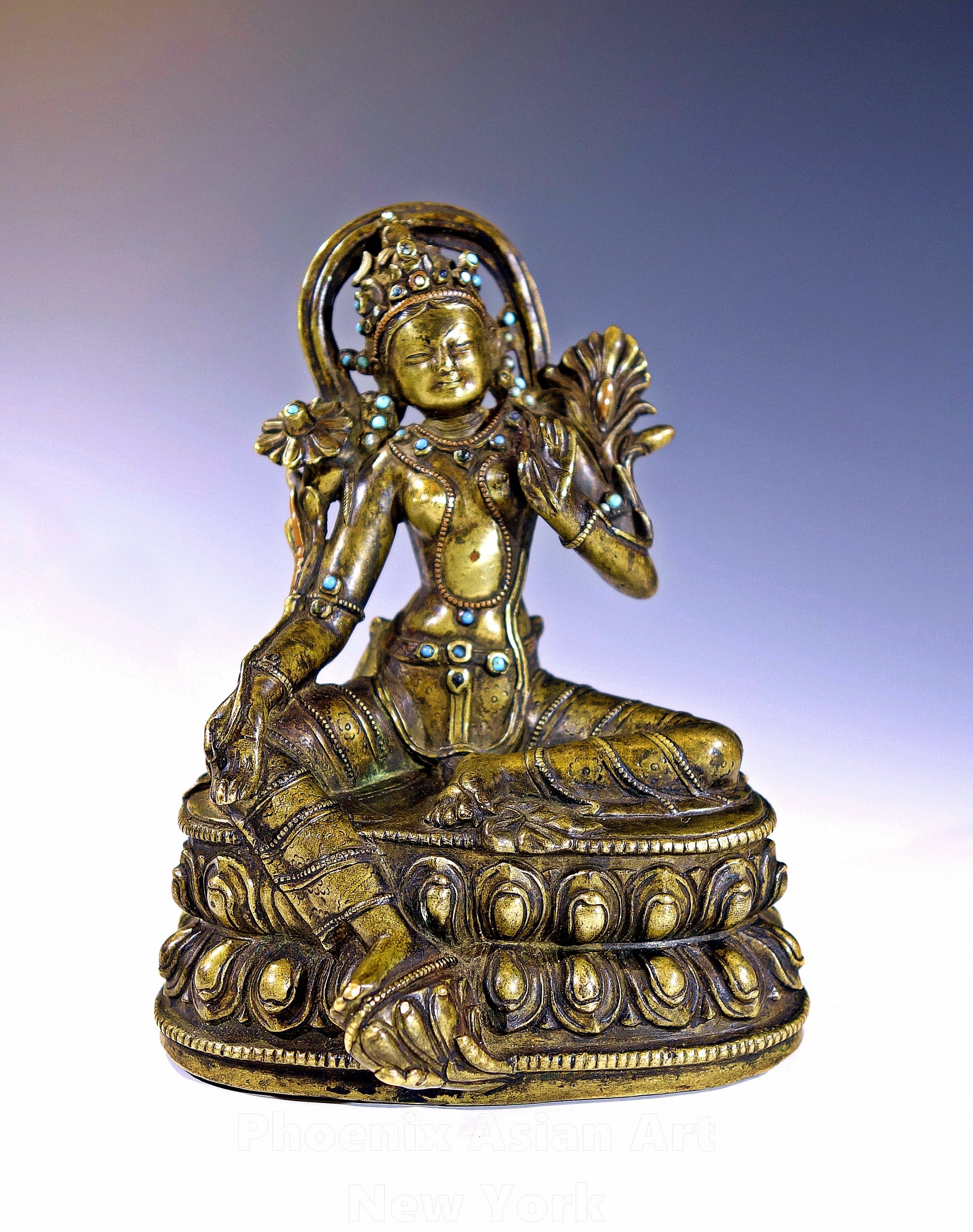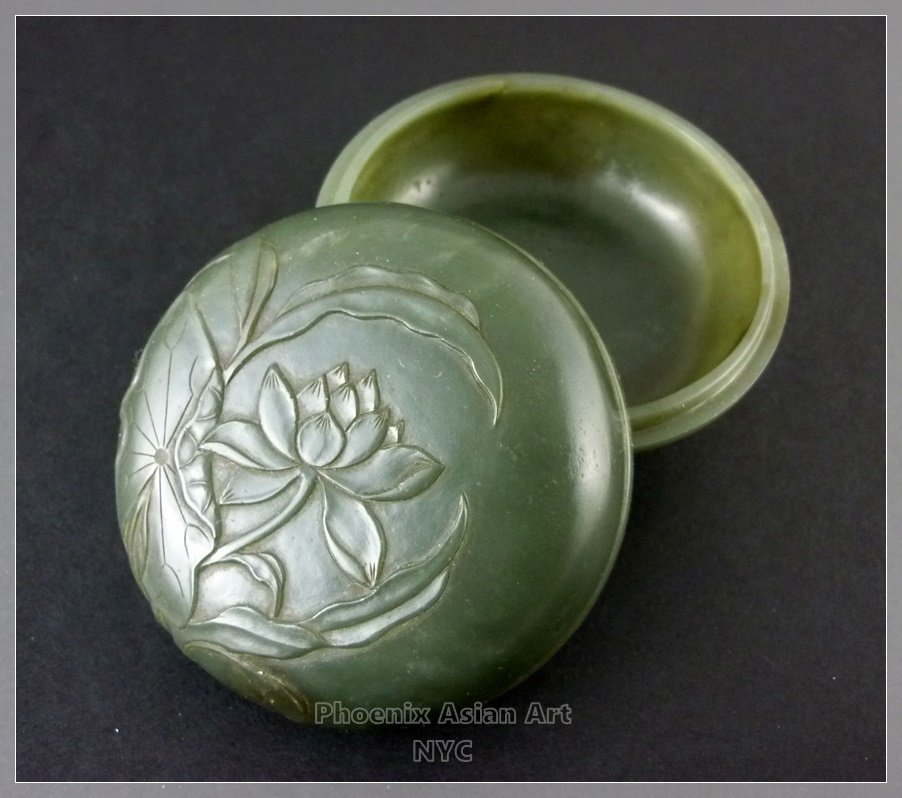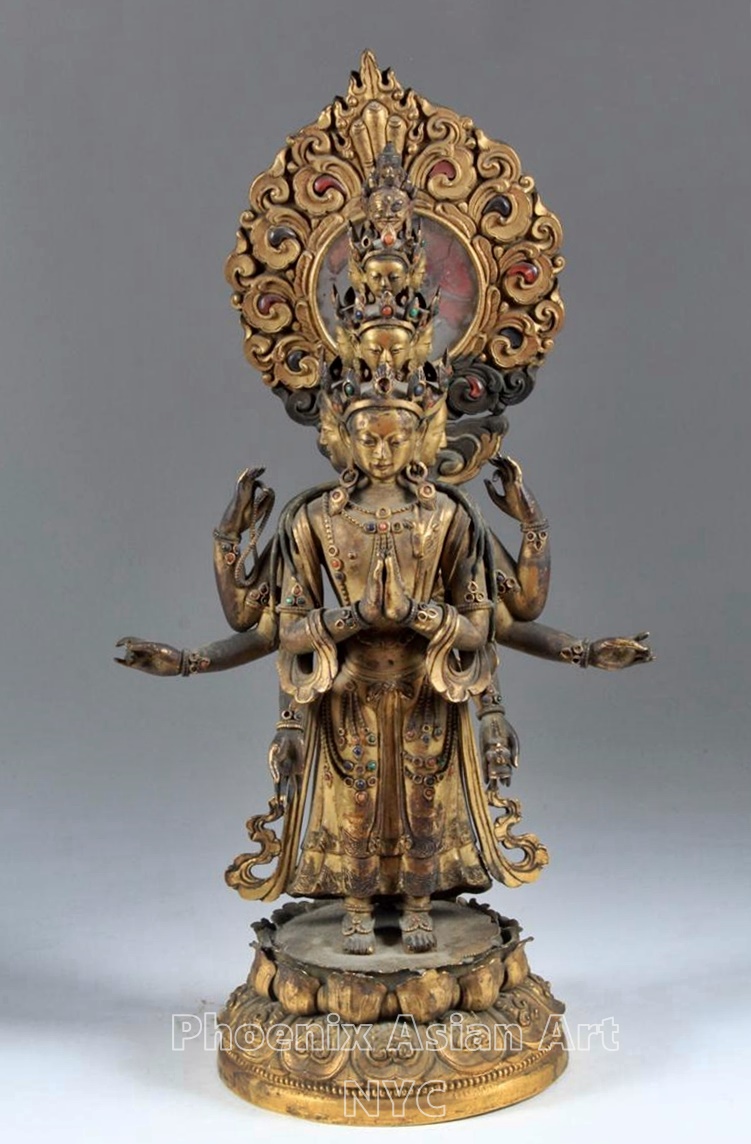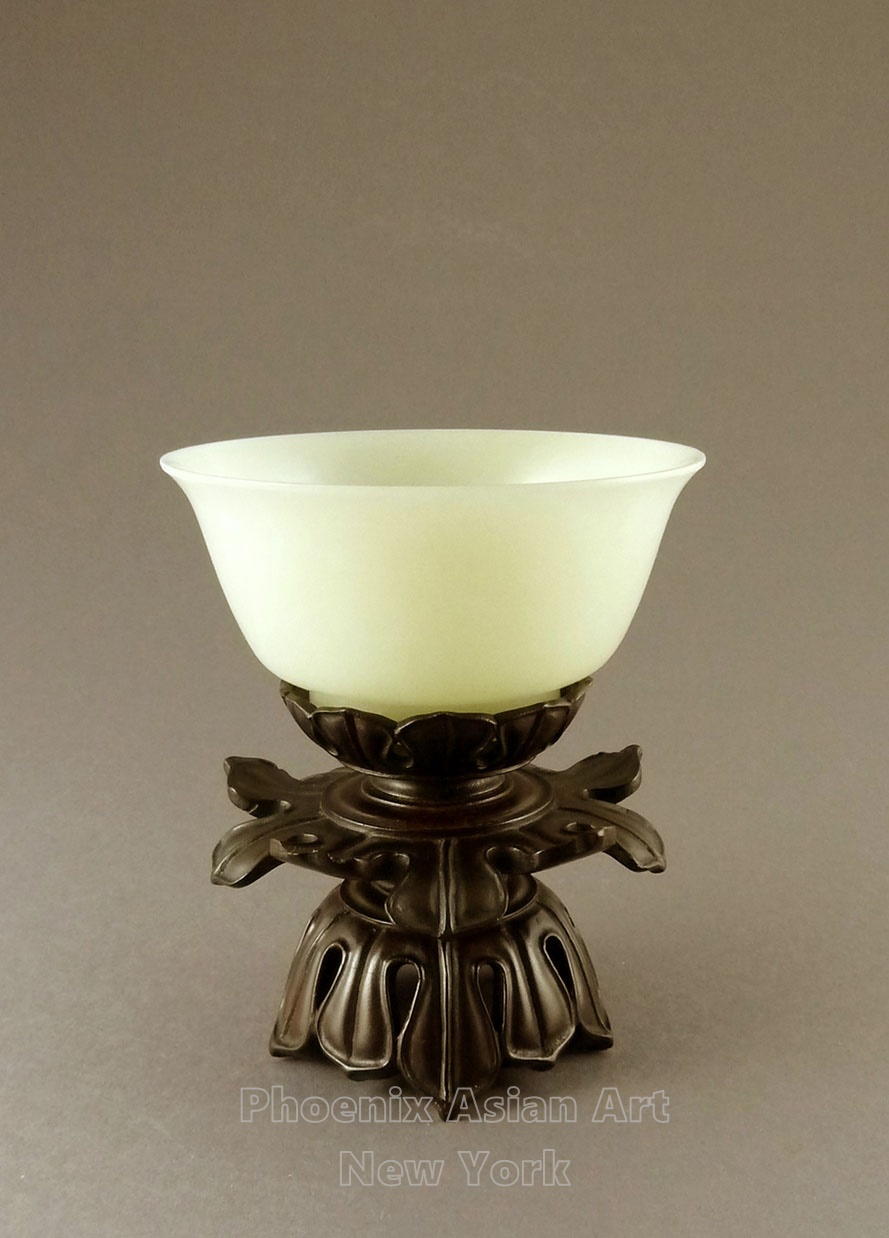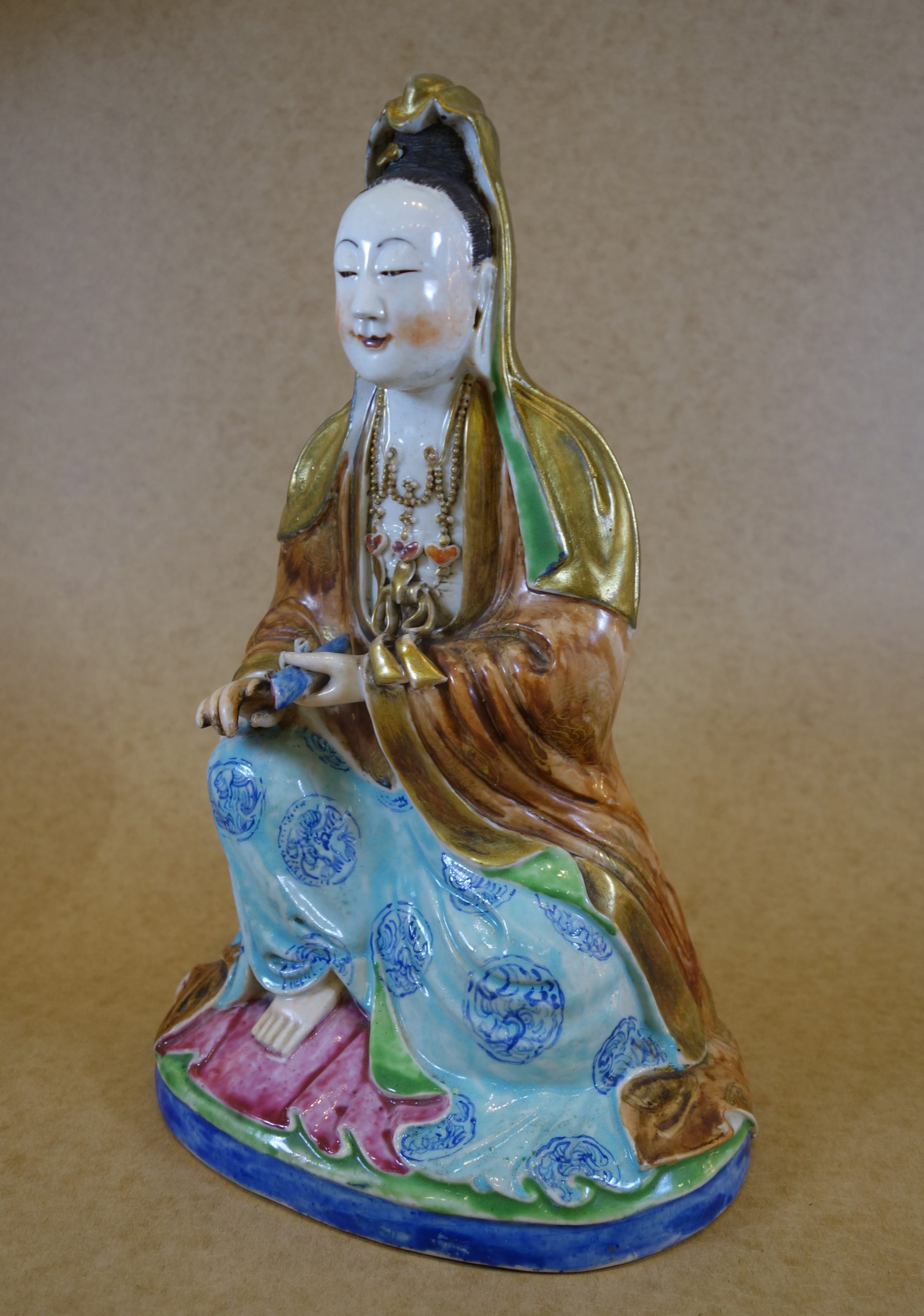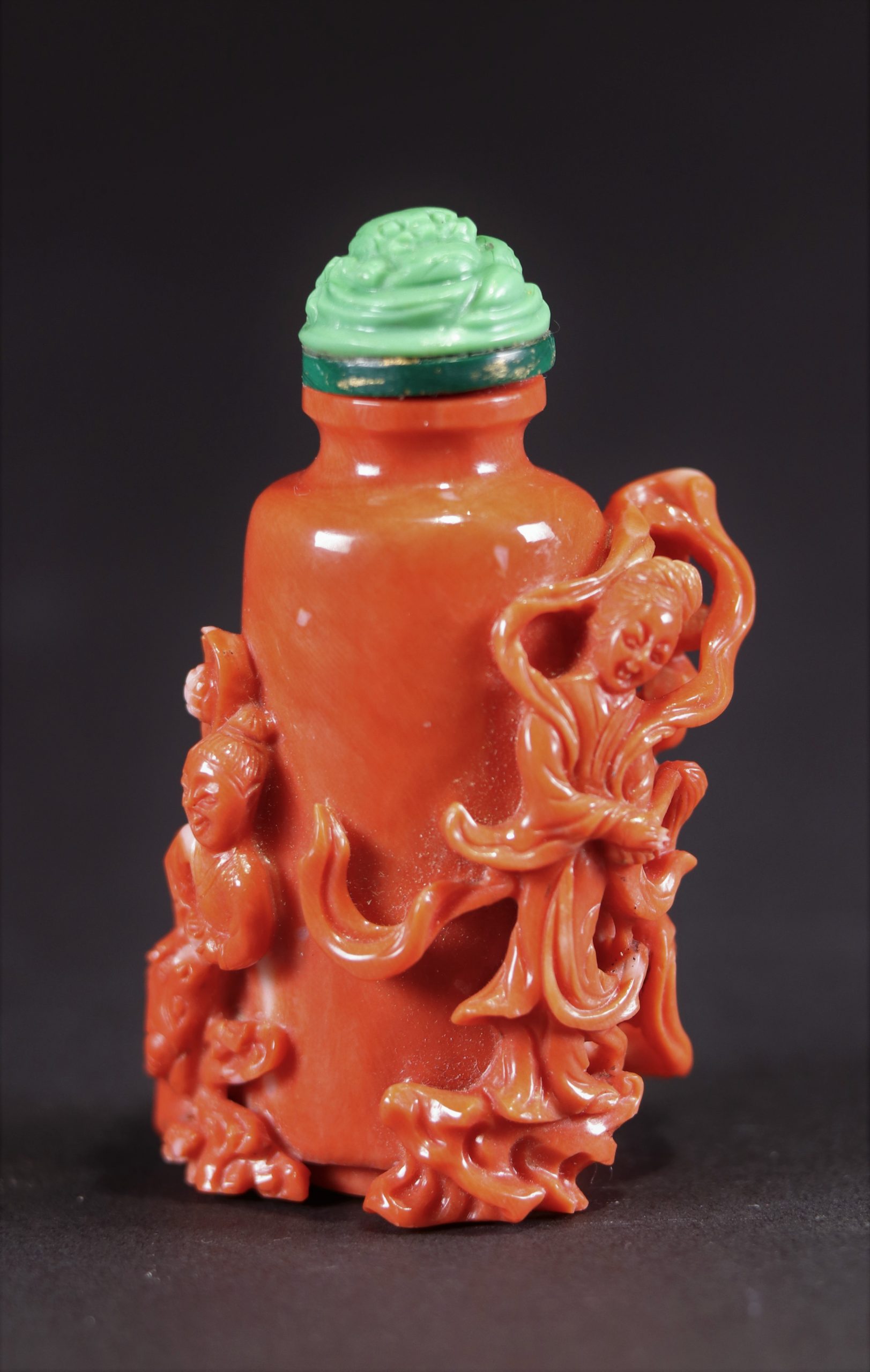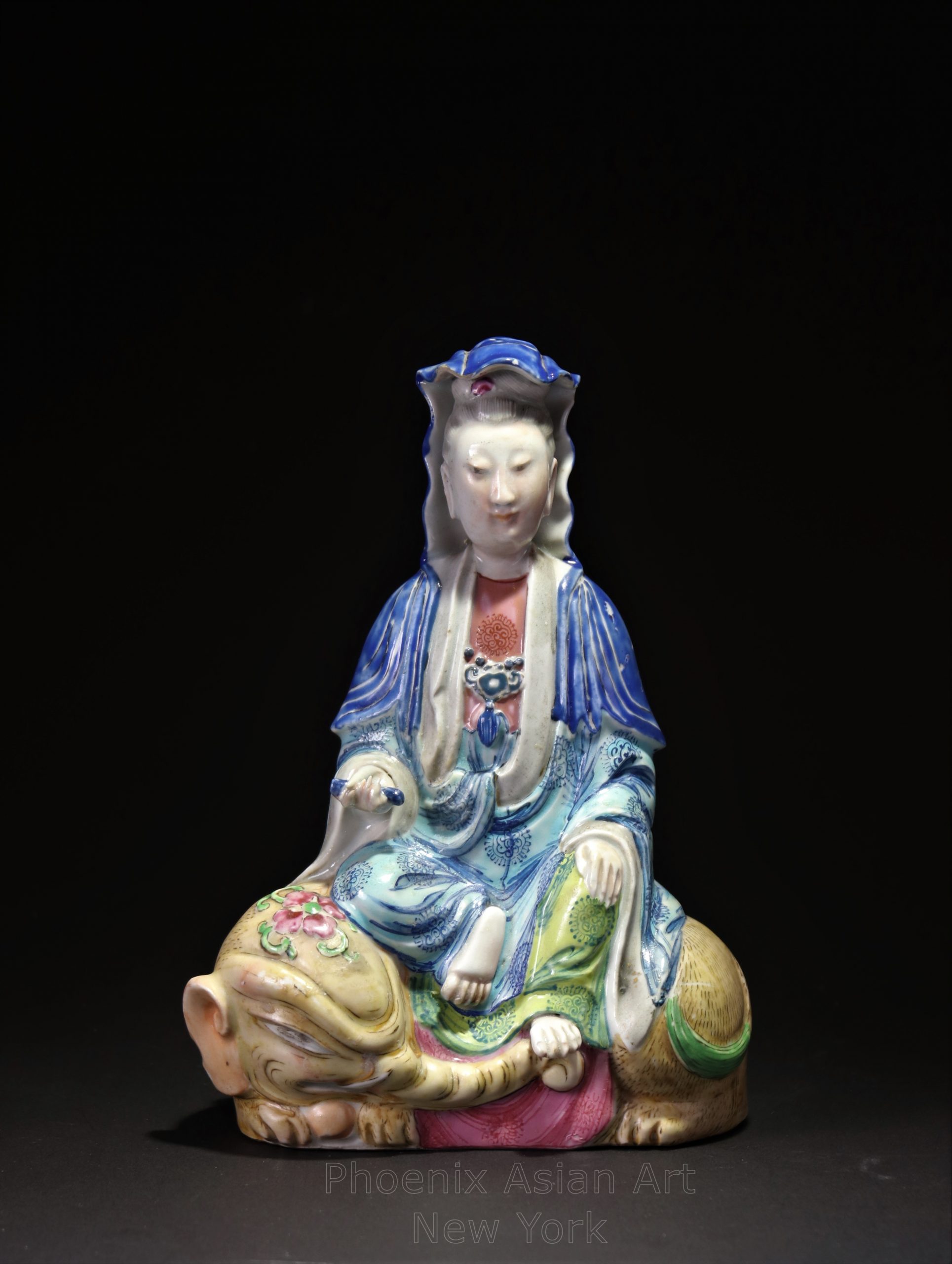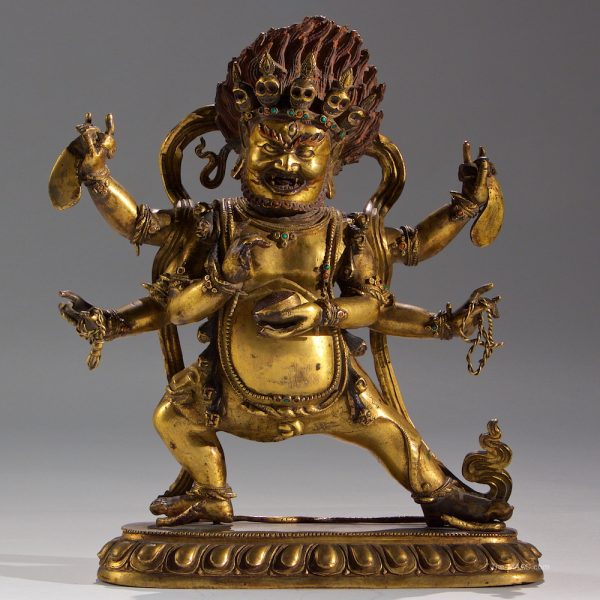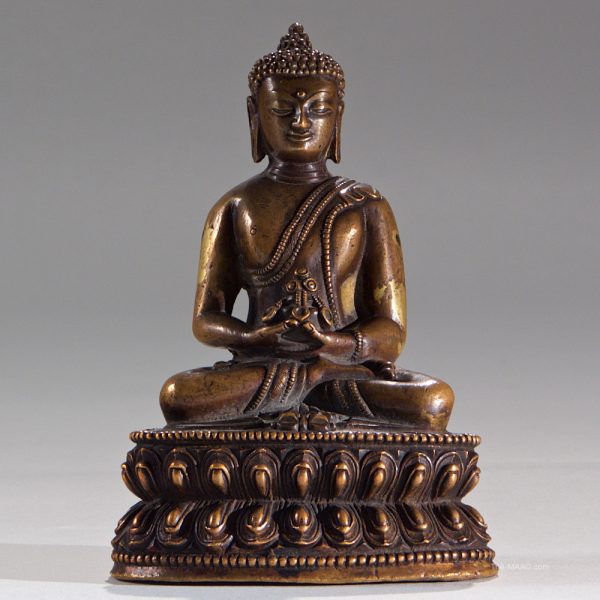Add to Wishlist
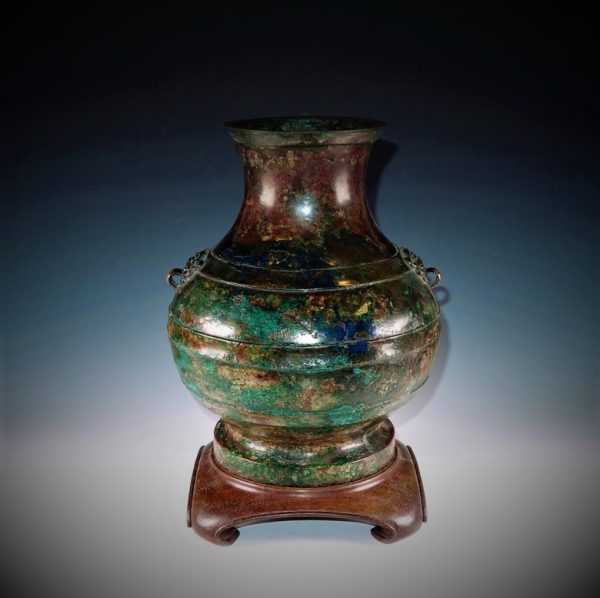
A Chinese Archaic Bronze Hu Vessel – Warring State Period (475–221 BC)
A Chinese Archaic Bronze Hu Vessel – Warring State Period (475–221 BC) 战国青铜壶. A hu is a type of wine vessel that has a pear-shaped cross-section. Its body swells and flares into a narrow neck, creating S-shaped profile. Most Chinese bronze vessels fall into two categories, food vessels or wine vessels. Hu vessels were used for holding wine, but not as drinking vessels. Hu were an important part of religious and cultural rituals.
Add to Wishlist
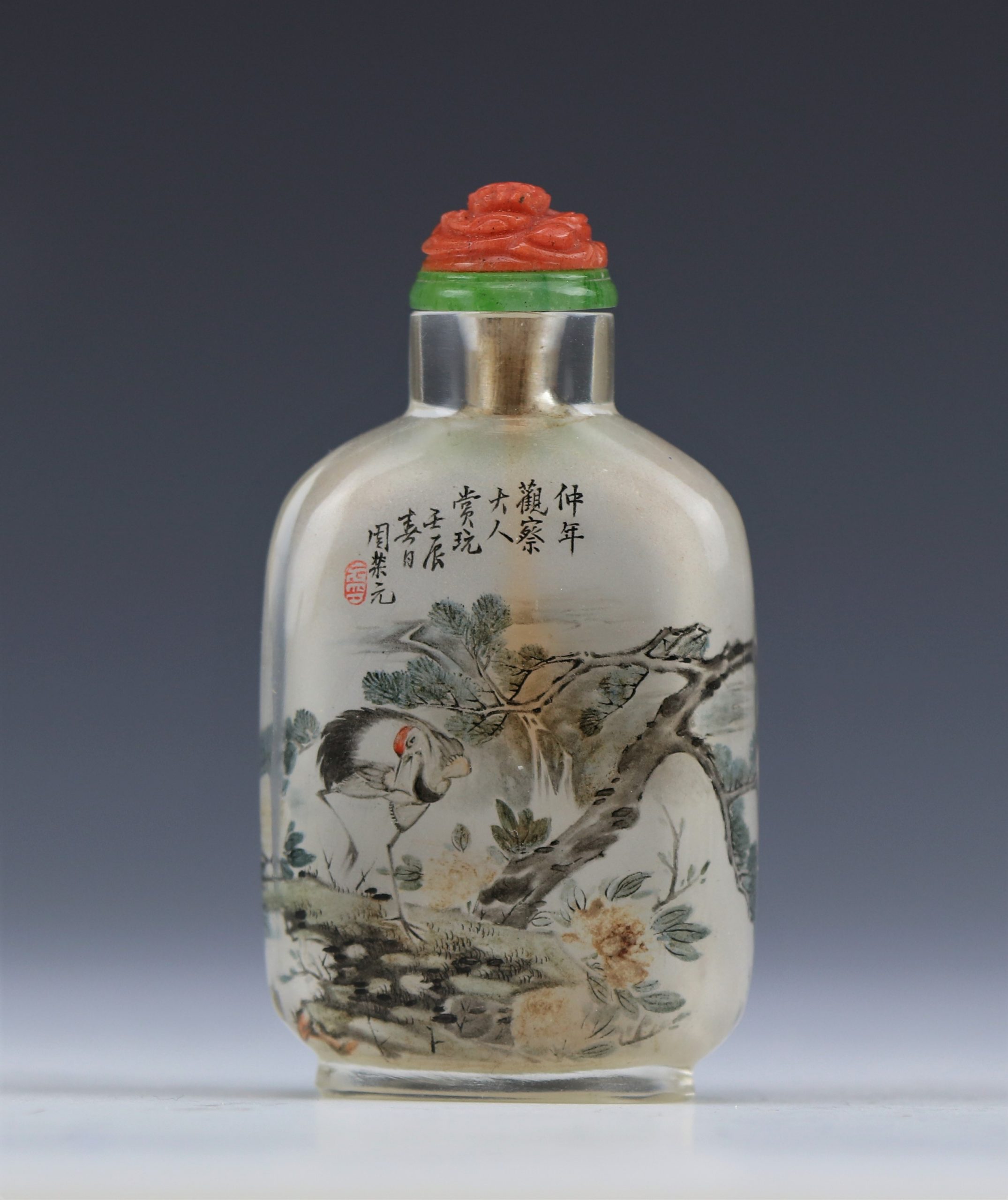
AN INSIDE-PAINTED CRYSTAL SNUFF BOTTLE BY ZHOU LE YUAN
dated Spring 1892 by Zhou Leyuan.
Add to Wishlist
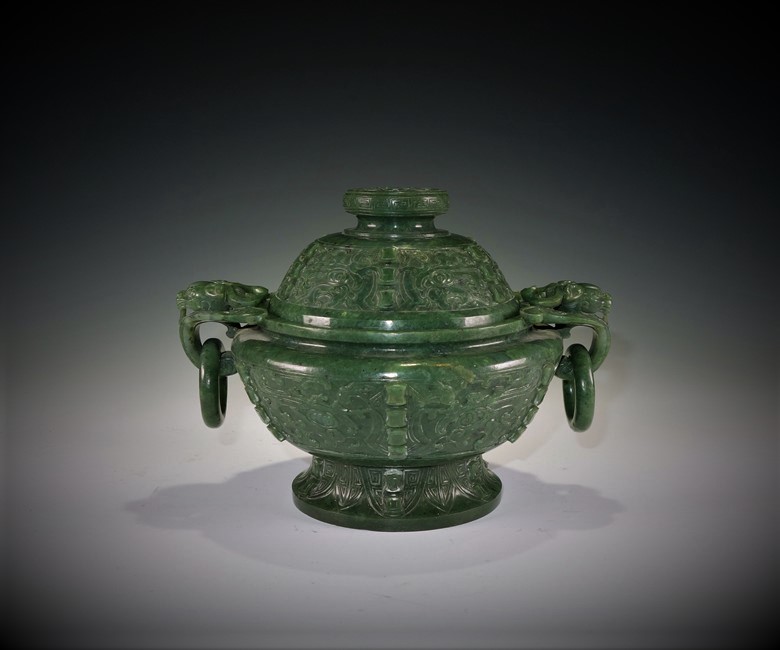
Add to Wishlist
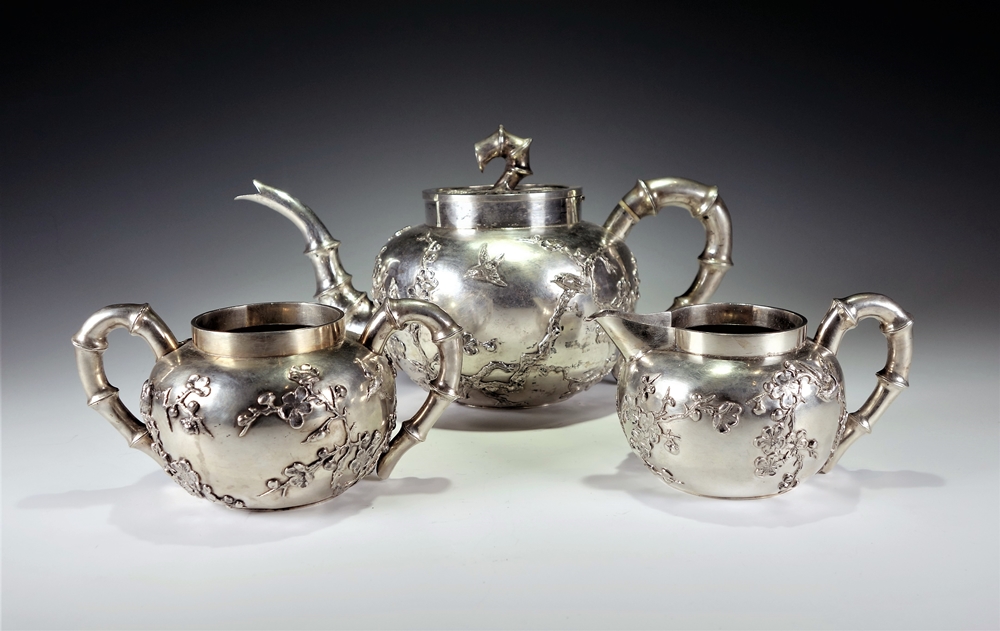
A Chinese Export Silver Tea Set – Late 19th Century
A Chinese export silver tea set made with bird and flower motif. Fine repousse work. Bamboo form handle and spout. Chinese mark on bottom. In overall good and clean condition. Weight of three pieces total: grams ( oz)
Add to Wishlist
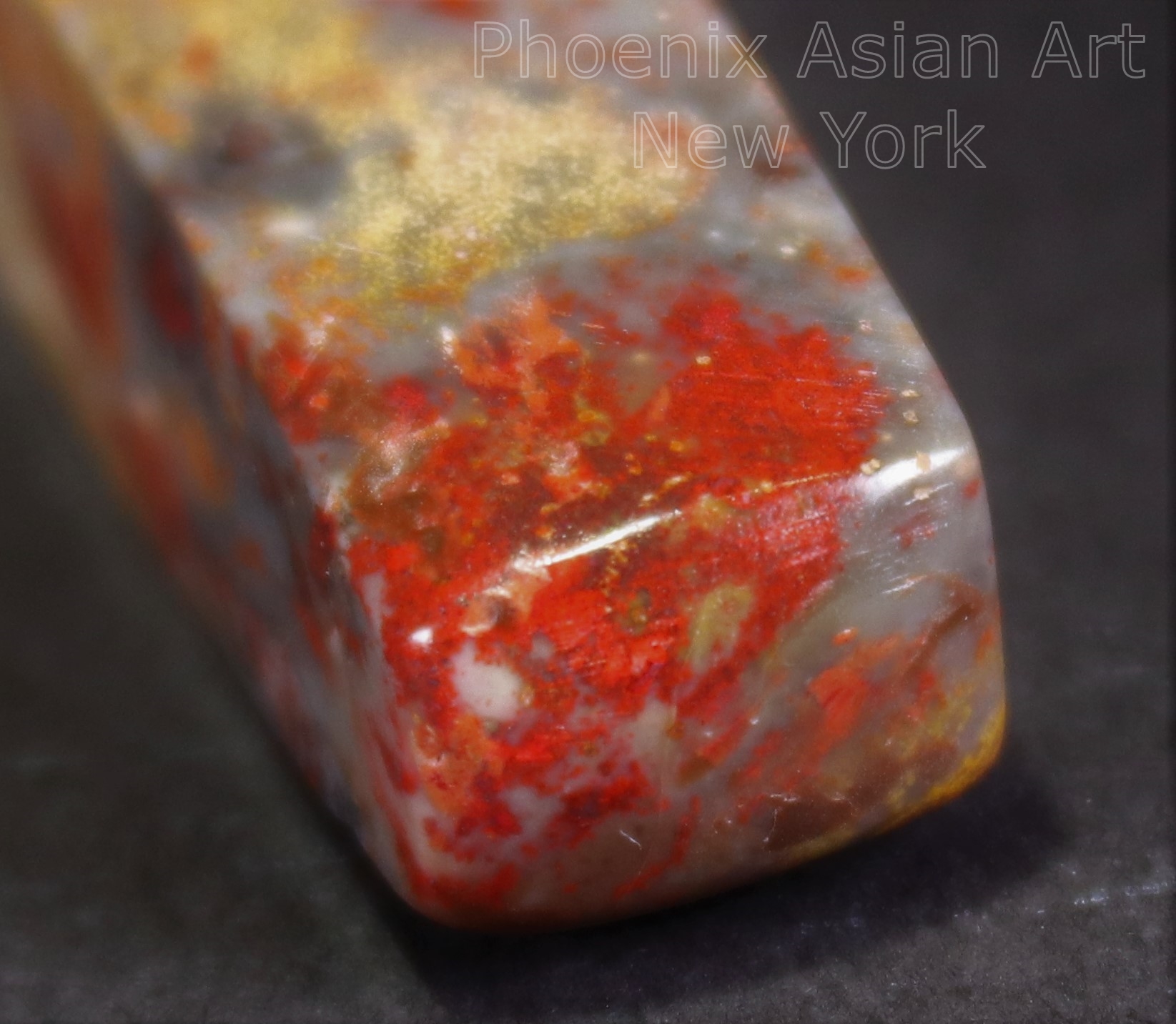
Chinese Changhua Chicken Blood Seal Stone (Liu Guan Zhang) 昌化鸡血石 (刘关张)
Chinese Changhua chicken blood seal with yellow, red and black color. This kind of three color combination is often called “Liu, Guan, Zhang”. This uncarved seal is likely from the republic period.
Good condition as shown in the photos. Guaranteed genuine Changhua chicken blood stone.
Size: 5 cm tall
Provenance: from a Hawaii Collector
昌化鸡血石 (刘关张)
- $800.00
Add to Wishlist
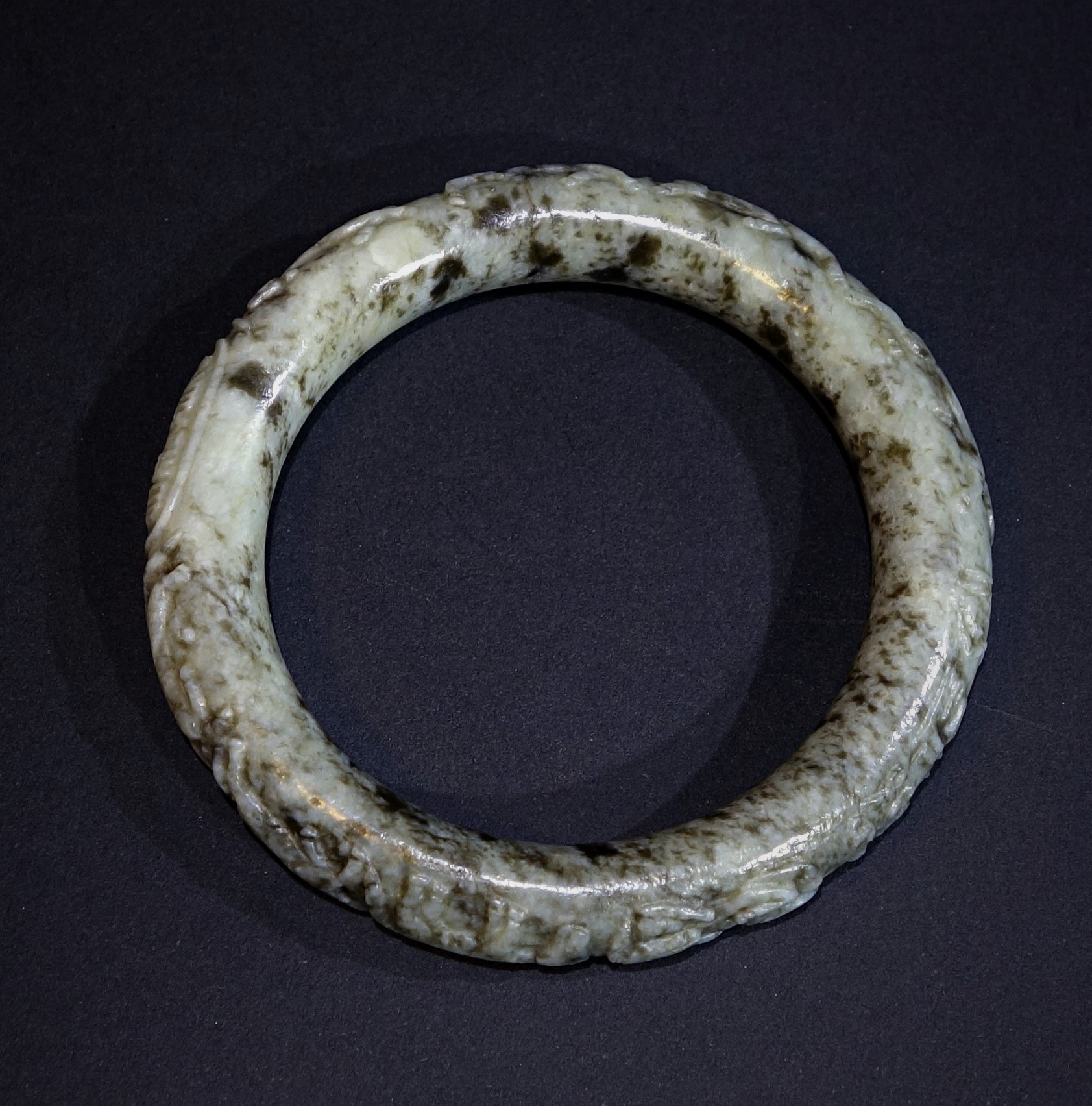
A Rare Chinese Liao or XiXia Jade Bangle with Horses – circa 1000 AC 辽或西夏 马纹玉镯
This rare antique Chinese jade bangle is likely from theChinese Liao or Xixia period, which was about 1000 AC. The jade stone with dark spots are typical of that period, which jade material is hard to find today. The bangle is decorated with eight horses and some characters. The characters looks like ancient Chinese but can not be read. Liao and XiXia used characters, which looked like Chinese, but were not the Chinese we know. The horses were walking, running, rolling… The cutting techniques used were simple but the horses are full of life and energy. Great patina. This bangle is in good antique condition with no chip or break or restoration. Any jade from these two dynasties are very rare and hard to find.
Size: 8.5 cm outside diameter, 6.14 cm inside diameter.
Provenance: from a Philadelphia collector
Add to Wishlist
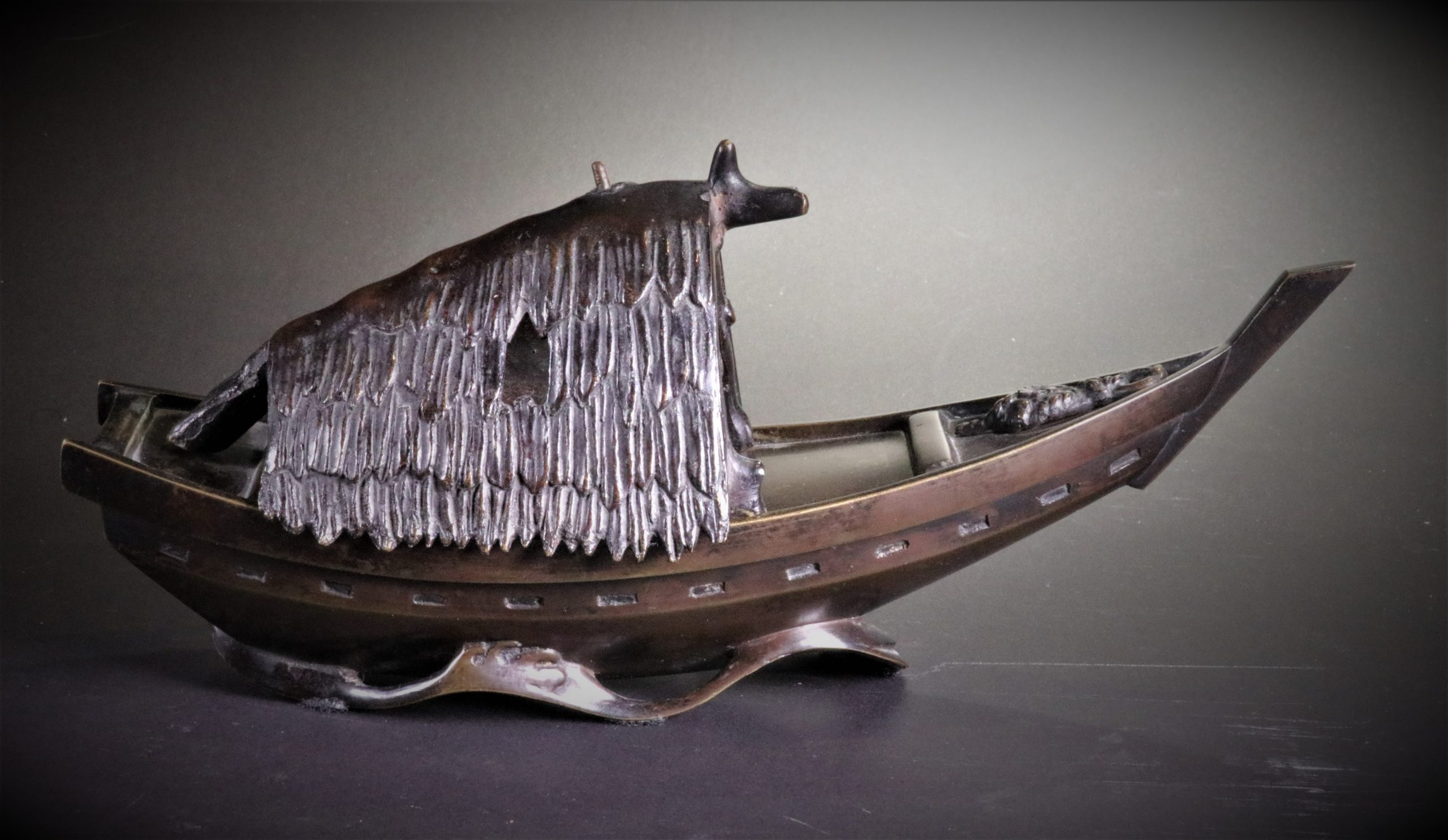
A Boat Shaped Censer 20th Century 乌篷船香炉
A patinated brass incense burner in the shape of a fishing boat. 2-part, top cover can be removed.
Size:
Add to Wishlist
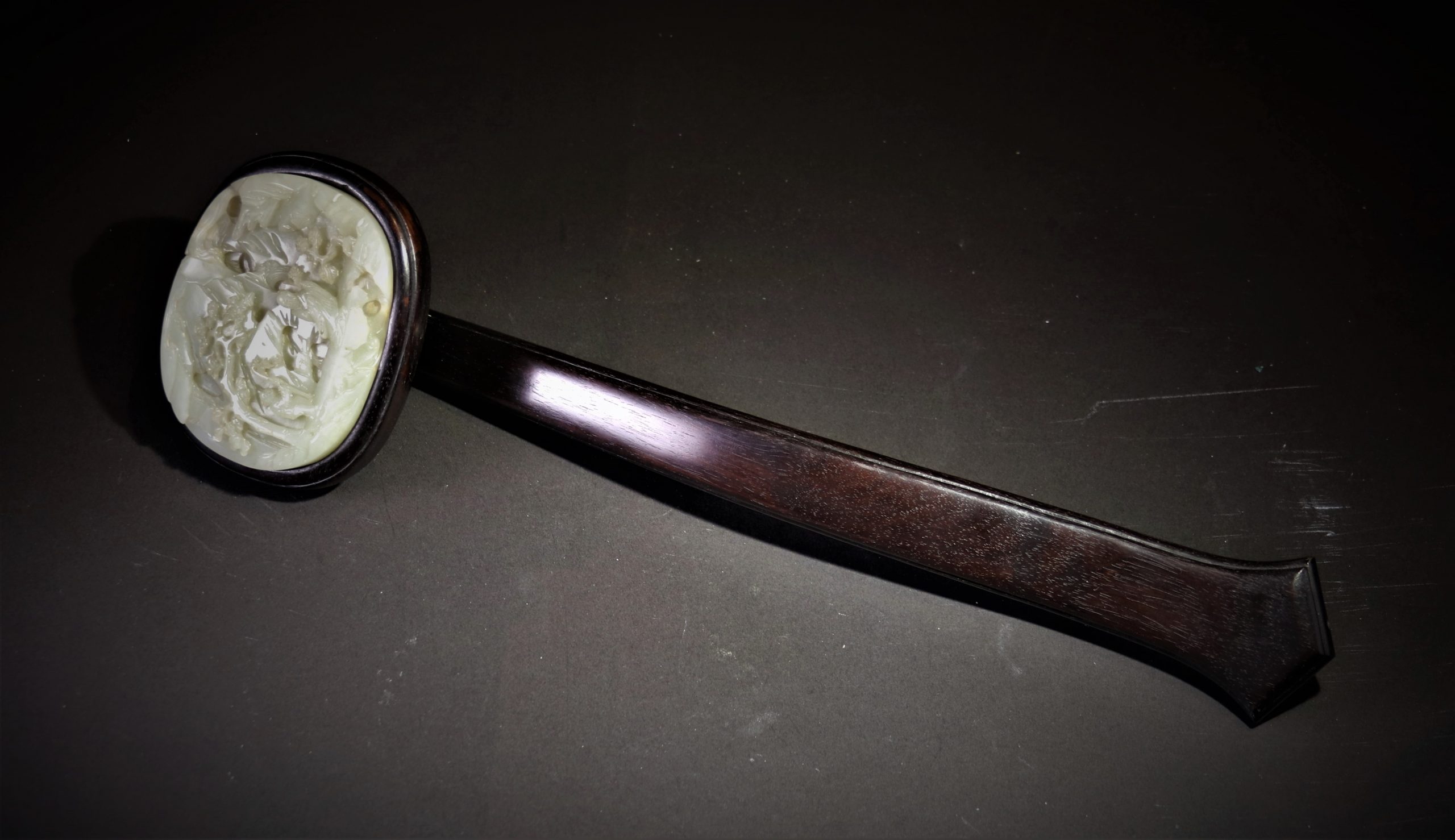
A Chinese Jade Ruyi Scepter with Zitan Wooden Handle 18th Century 清十八世纪紫檀柄玉如意
A Chinese Jade Ruyi Scepter with Zitan Wooden Handle of oval outline, deeply carved with a scene of a sage and attendant on a mountain path, walking between trees with swirling clouds above, the finely carved jade stone inset into the head of a zitan scepter with an elegantly curved shaft, terminating in a triangular tip with a bull-nose perforation. The jade carving is typical work of 18th century qianlong period, and was likely from the work of the imperial work shop. Ruyi (Chinese: 如意; literally: ‘as desired; as [you] wish’) is a curved decorative object that serves as either a ceremonial scepter in Chinese Buddhism or a talisman symbolizing power and good fortune in Chinese folklore.
The jade plaque 3 5/8in (9.2cm) wide. Total length of ruyi is 15″ (38 cm)
清十八世纪紫檀柄玉如意
Add to Wishlist
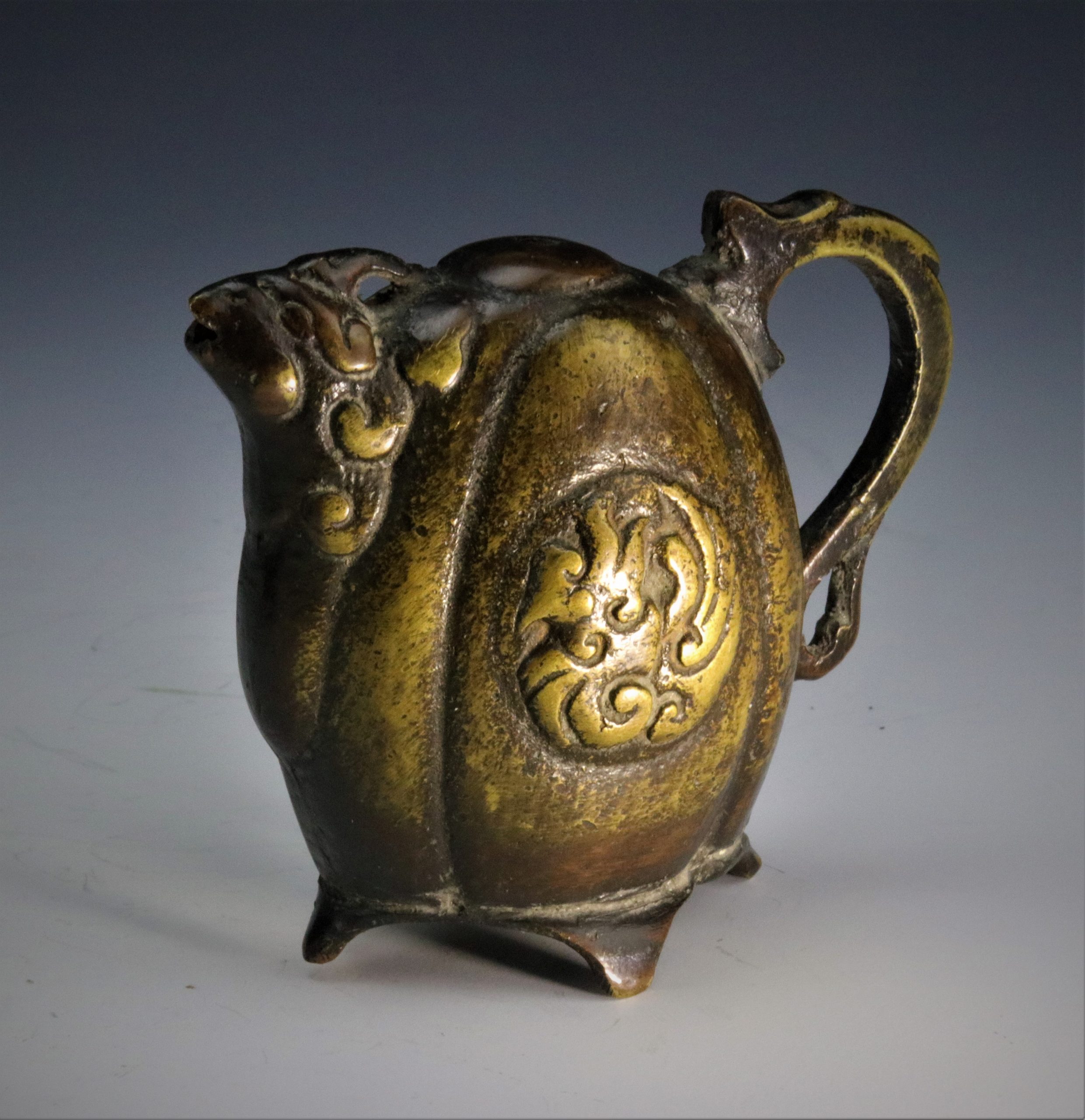
A Chinese Scholar Bronze Water Dropper – Ming Dynasty 明代铜砚滴
This bronze water-dropper (Chinese: 水滴) bronze water dropper is in shape of a mythical beast. It is used by Chinese scholar in calligraphy as a container designed to hold a small amount of water. In order to make ink a few drops of water are dropped onto an ink stone. By grinding an inkstick into this water on the inkstone, particles come off and mix with the water, forming ink. This water-dropper has two small holes for water and air, and is designed so that only a few drops of water can fall at one time.
Add to Wishlist
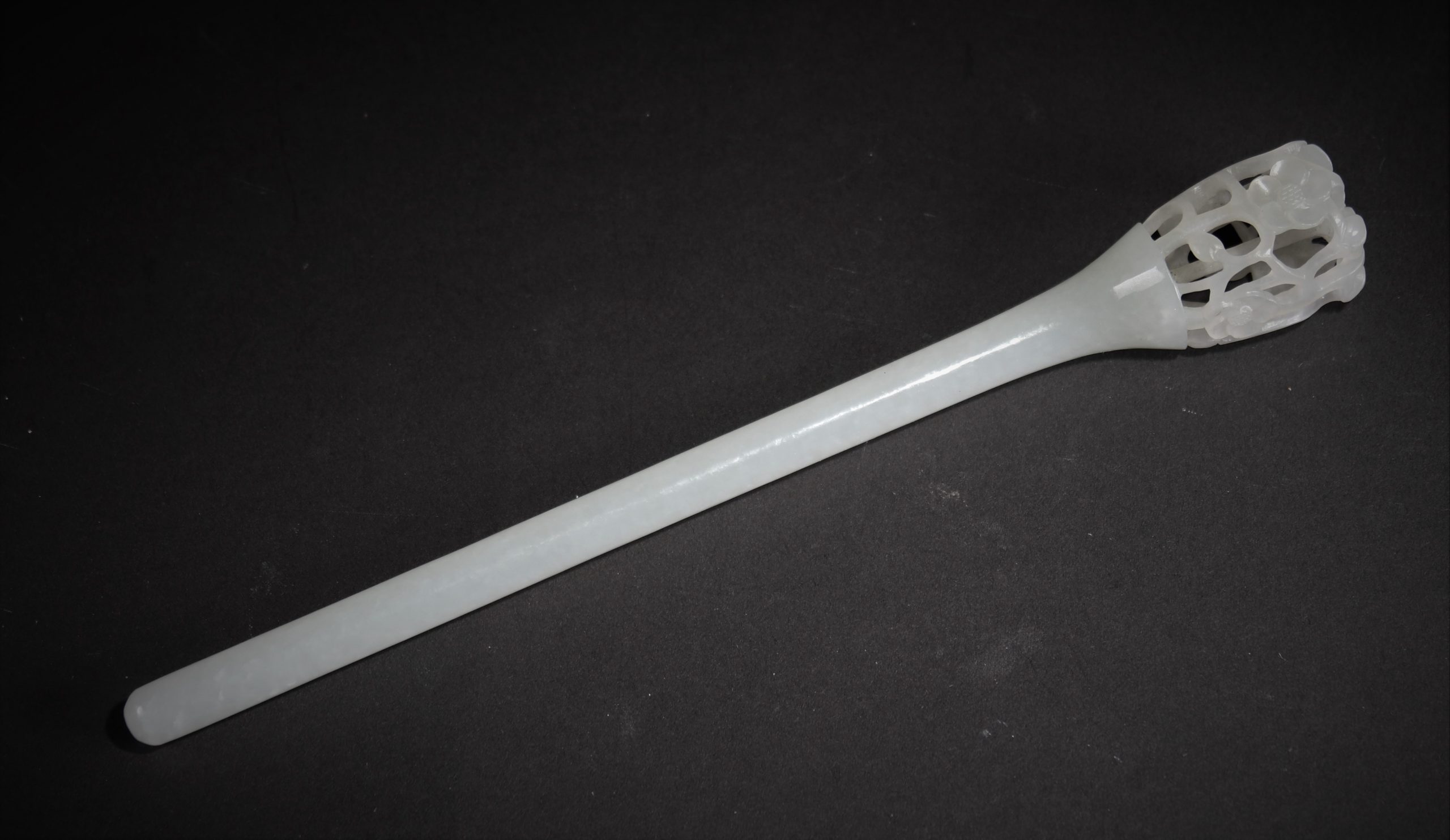
A White Jade Carved Hair Pin – Ming Dynasty 明代白玉发簪
The pure white cylindrical shaft elegantly carved and undercut at one end with the plum flower elements. The plum blossom, which is known as the “meihua” (梅花), is one of the most beloved flowers in China and has been frequently depicted in Chinese art and poetry for centuries. … Therefore, the plum blossom came to symbolize perseverance and hope, as well as beauty, purity, and the transitoriness of life.
Length: 7-7/8″ long (20cm)
Reference: In Sep 2019, a similar jade hair pin was sold in Sotheby’s New York in the Chinese Art From the Metropolitan Museum of Art: THE FLORENCE AND HERBERT IRVING GIFT, Lot 28.
2019年9月10日,纽约苏富比的大都会博物馆专场拍卖中有一件很近似的玉簪。拍品号28。本件玉簪与上述28号拍品原来很可能是一大一小的同一套件。
Add to Wishlist
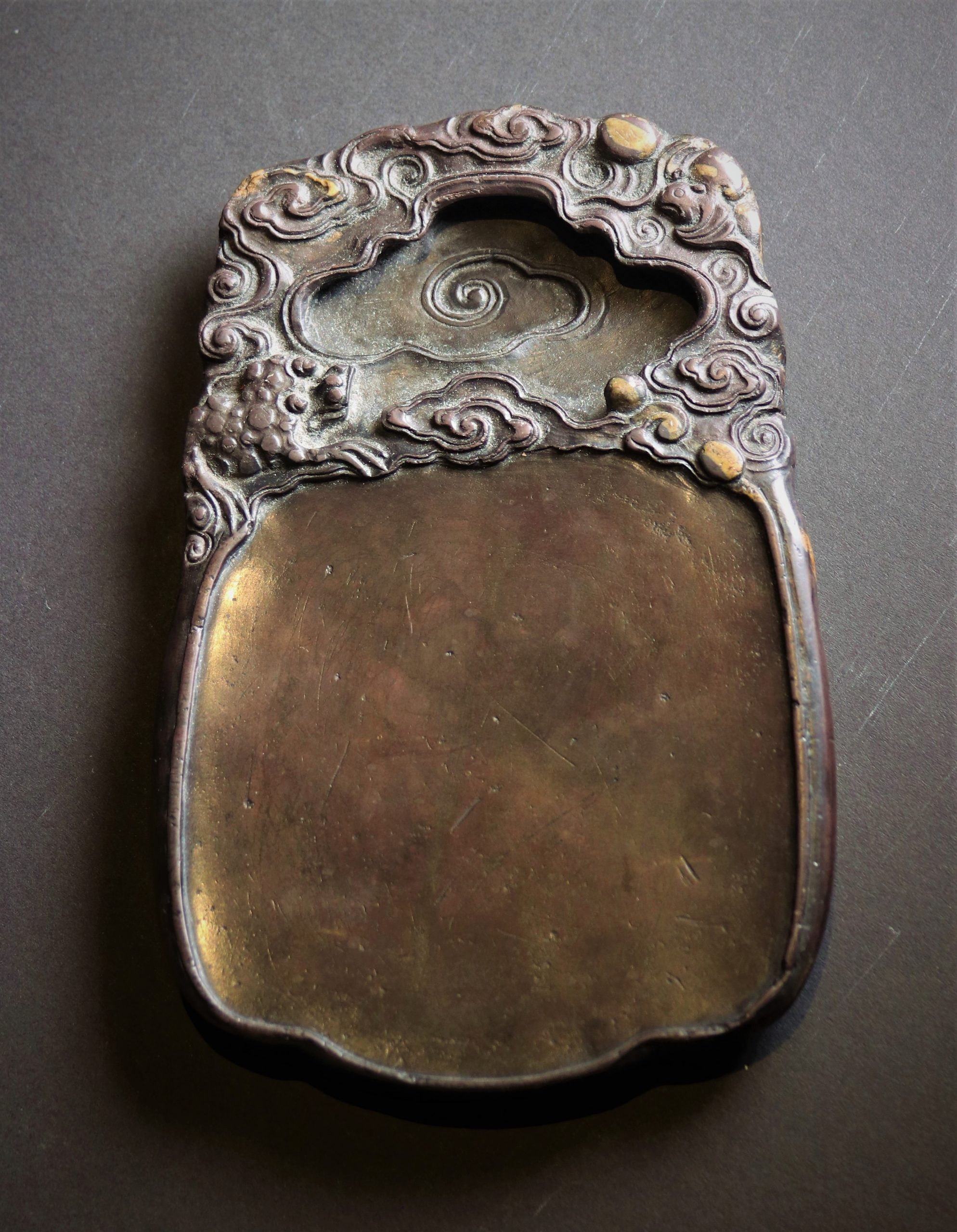
A Carved Chinese Scholar Duan Ink Stone – 17th Century Kangxi Period 清康熙“福在眼前”端砚
Produced in Zhaoqing city, Guangdong province in South China, in over 1000 years, the Duan inkstone has been one of the most famous inkstones in China. Duan inkstones were first produced during the Wude reign (618-626) of the Tang Dynasty (618-907). It is made of Duan stone from the Duanxi River running at the foot of Lanke Mountain, hence the name. Famed as the stone material being very fine and doing no damages to the writing brush. Duan inkstone has had a high reputation among Chinese scholars ever since. The key to making Duan inkstones is collecting the proper stones. It was very hard to hand pick flawless stones in ancient China. Any cracks inside the stone can cause damage during carving. The cave where the duan stone was mined was only about 80cm high, and collectors had to squat, sit or lie down to collect the stone. Therefore, a good old duan ink stone is not easy to come by in ancient China.
Size:
Condition: Very good condition with no damage or repair.
清康熙“福在眼前”端砚
Add to Wishlist
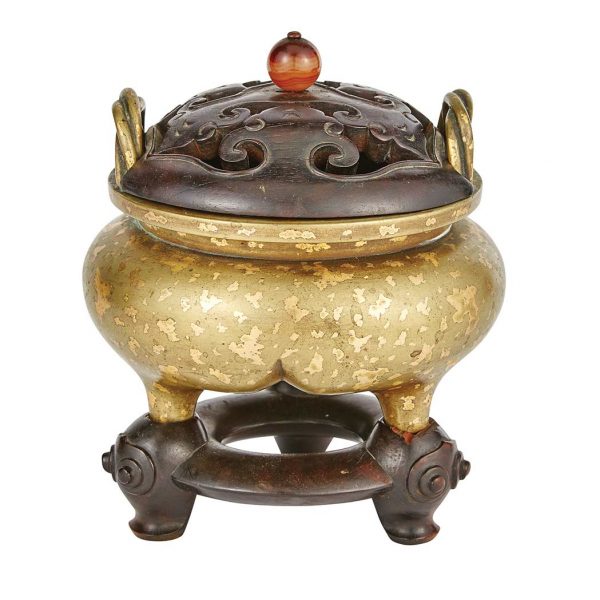
A Chinese Bronze Censer with Rope Handle and Gold Splash – 17th Century 晚明索耳点金铜炉
An elegant Chinese bronze gold splash tripod censer, with six character Xuande mark, 17th century late Ming dynasty. With loop handles rising from the flared rim. A gold splashed bronze censer has always been considered as higher end bronze censer in ancient China.
Size: 5-1/2″ diameter (14 cm). Weight: 1.5 lbs.
Condition: Bronze in very good condition. Wood lid and base with light surface wear.
Add to Wishlist

Antique Chinese Scholar Huanghuali Brush Pot – 17/18th Century 清早期黄花梨笔筒
A fine Chinese huanghuali Brush pot for scholar from the 17-18th century. slightly curved body shows elegance and good scholar taste. Nice wood grain with good original patine inside and out.
Size: 5.25″H x 4.55″D
Good antique condition with no repairs.
清早期黄花梨笔筒
Add to Wishlist
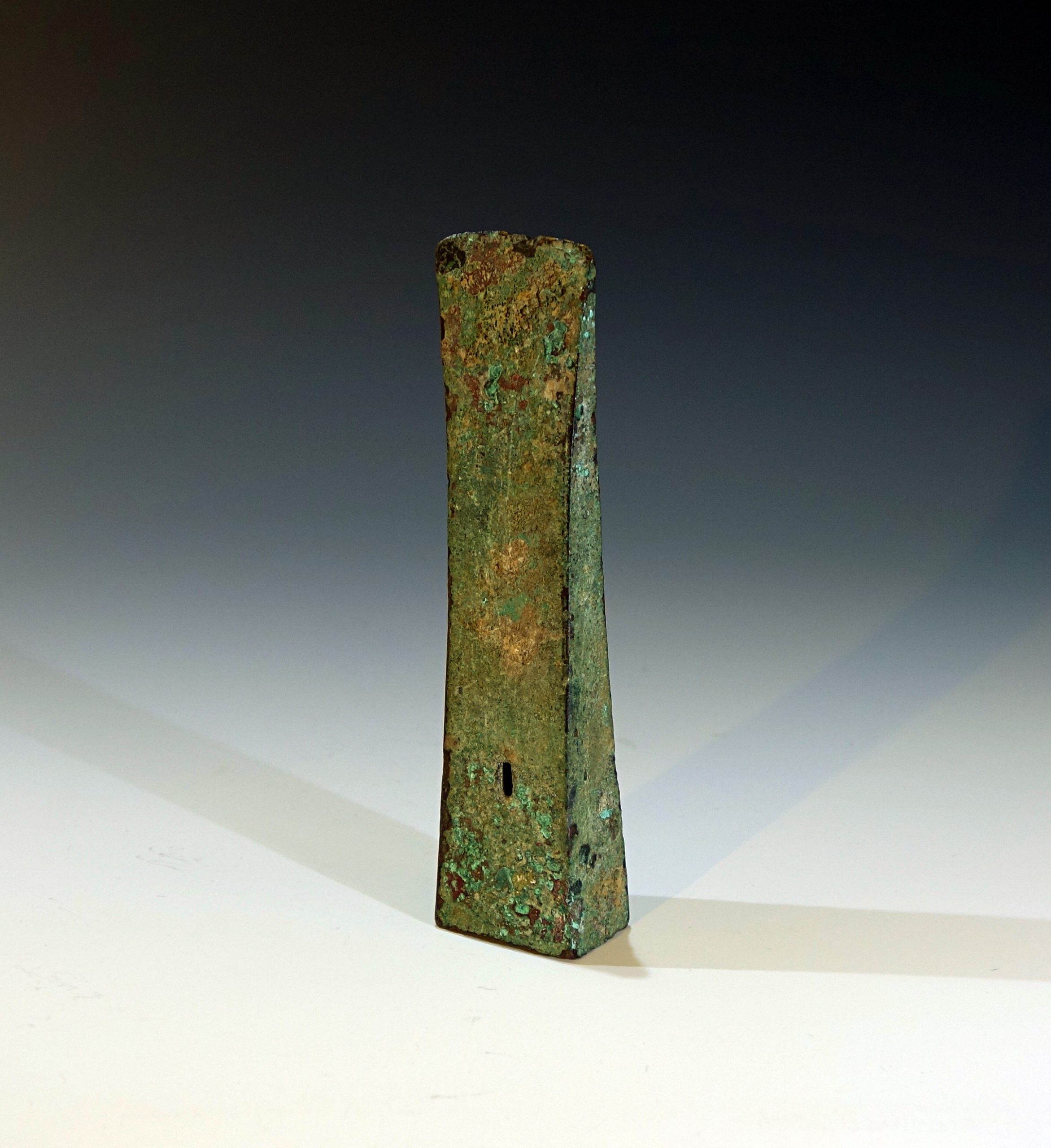
A Chinese Archaic Bronze Ax – Warring State Period 475-221 BC 战国时期青铜斧
Authentic antique Chinese Bronze Axe from the Chines Warring State Period 475-221 BC. Although the previous certificate stated this bronze axe was from the Chinese Han Dynasty (ca 206 – 220 ), It is very likely this bronze is from the Warring State period (475-221 BC) according to our study.
Size: 6″ long.
Condition: good antique condition with no repair.
Provenance: This bronze axe was from estate of Mr. John Piscopo, who was one of the largest collector of ancient weapons in the US. A Certificate of Authenticity will be provided to the buyer.
战国时期青铜斧
Add to Wishlist
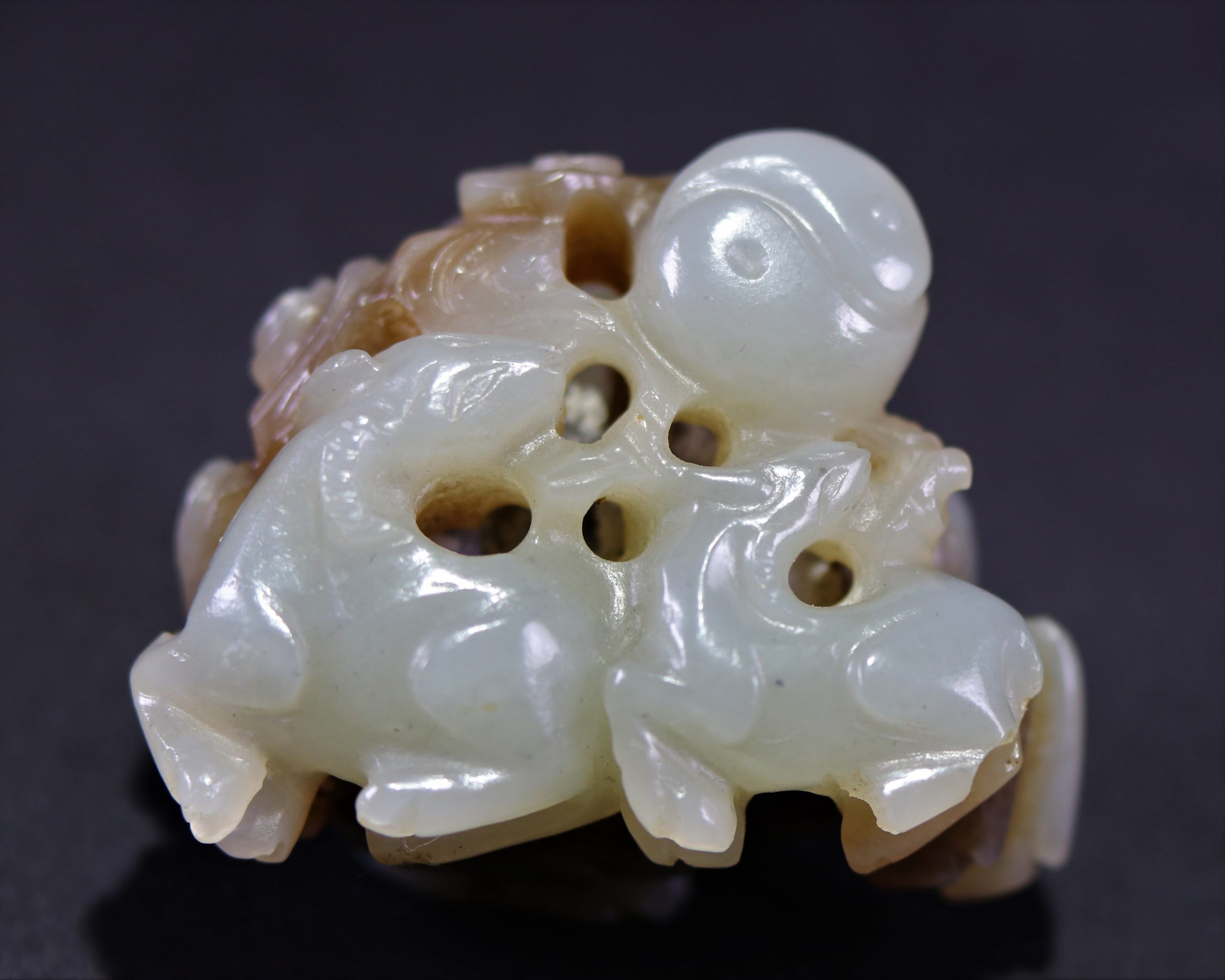
A Chinese Jade Carving of Three Rams – 17th Century 清康熙 三羊开泰 玉佩
The Chinese idiom, San Yang Kai Tai, (三羊开泰) means “three goats bring fortune”.
Add to Wishlist
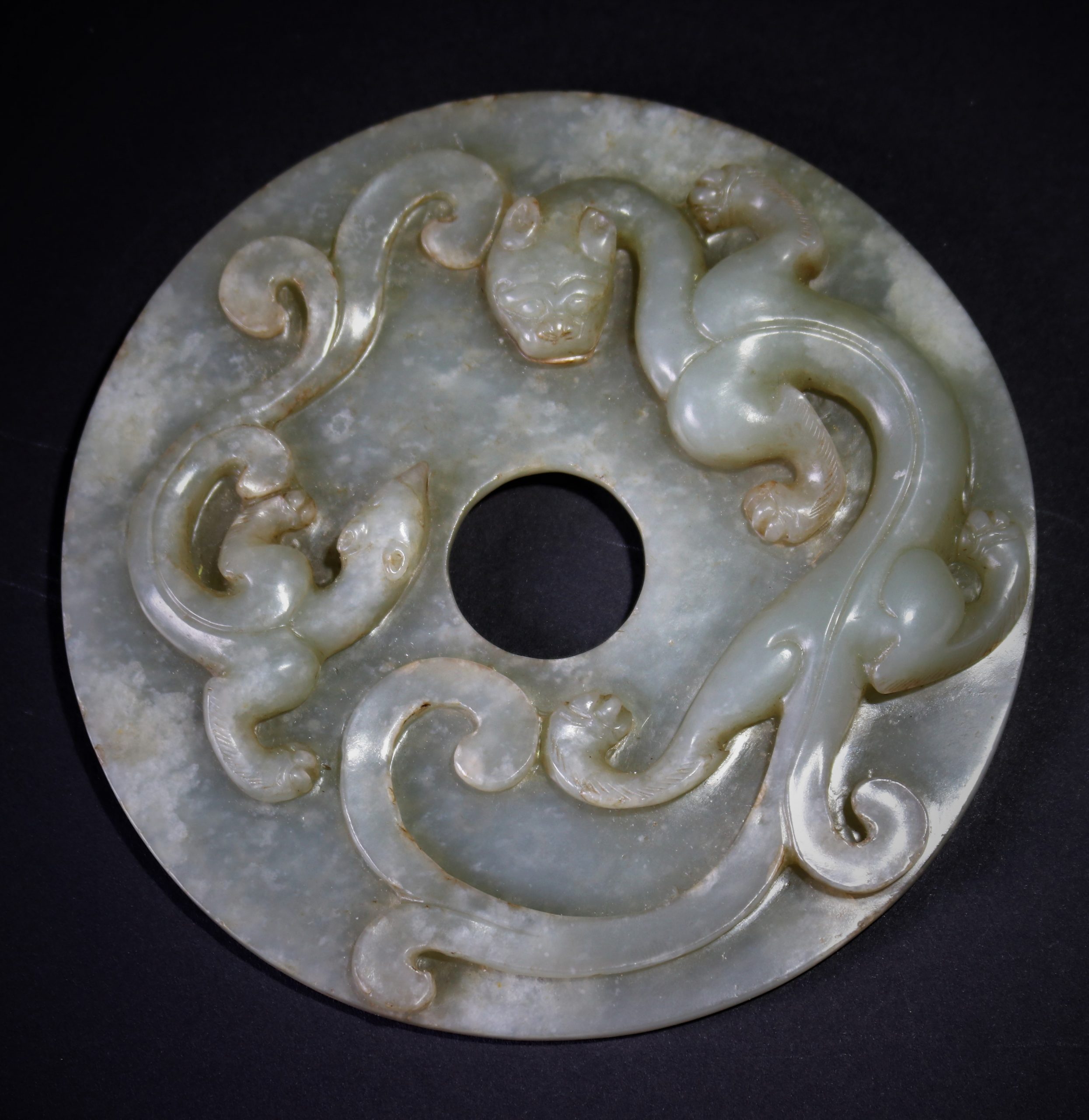
A Rare Chinese Jade Bi with Phoenix and Dragon – 18th Century 十八世纪 龙凤呈祥 谷纹玉璧
The bi is a type of circular ancient Chinese jade artifact. The earliest bi were produced in the Neolithic period. A bi is a flat jade disc with a circular hole in the centre. As laboriously crafted objects, they testify to the concentration of power and resources in the hands of a small elite. Later traditions associate the bi with heaven, and the cong with the earth. Bi disks are consistently found with heaven and earth-like imagery, suggesting that the disk’s circular shape also bears symbolic significance. Jade, like bi disks, has been used throughout Chinese history to indicate an individual of moral quality, and has also served as an important symbol of rank. The elite society had been making the jade Bi disk in almost every dynasty throughout the Chinese history. The jade Bi disk with both Dragon and Phoenix are rare. We all know the meaning of Dragon. Phoenix in Chinese is called Fenghuang. The fenghuang has very positive connotations. It is a symbol of high virtue and grace. The fenghuang and dragon together also symbolizes the union of yin and yang. The Chinese also considered the dragon-and-phoenix design symbolic of blissful relations between husband and wife, another common yang and yin metaphor.
A custom made display stand (as shown in photos) is included.
Condition: In very good antique condition with normal age wear.
Size: diameter
Provenance: From a private New York Collection
Add to Wishlist
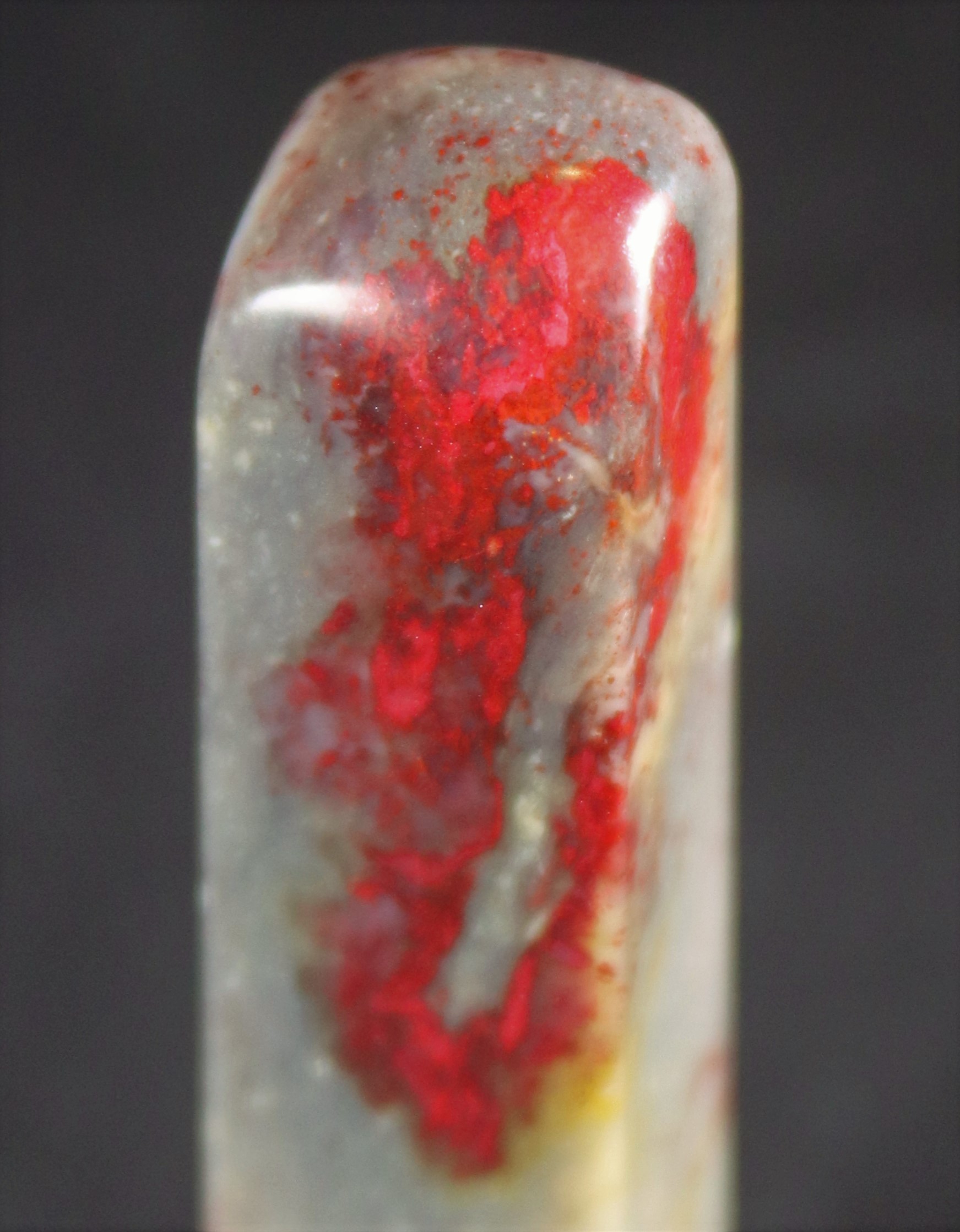
A Chinese Chicken Blood Seal Stone – 20th Century 昌化鸡血石章
Chinese Changhua chicken blood seal with bright red chicken blood color. This uncarved seal is likely from the 1970s-1980s. It still has an old sticker from a Chinese shop.
Good condition as shown in the photos. Guaranteed genuine Changhua chicken blood stone.
Size: 9 cm tall
昌化鸡血石 章料
- $1,800.00
Add to Wishlist
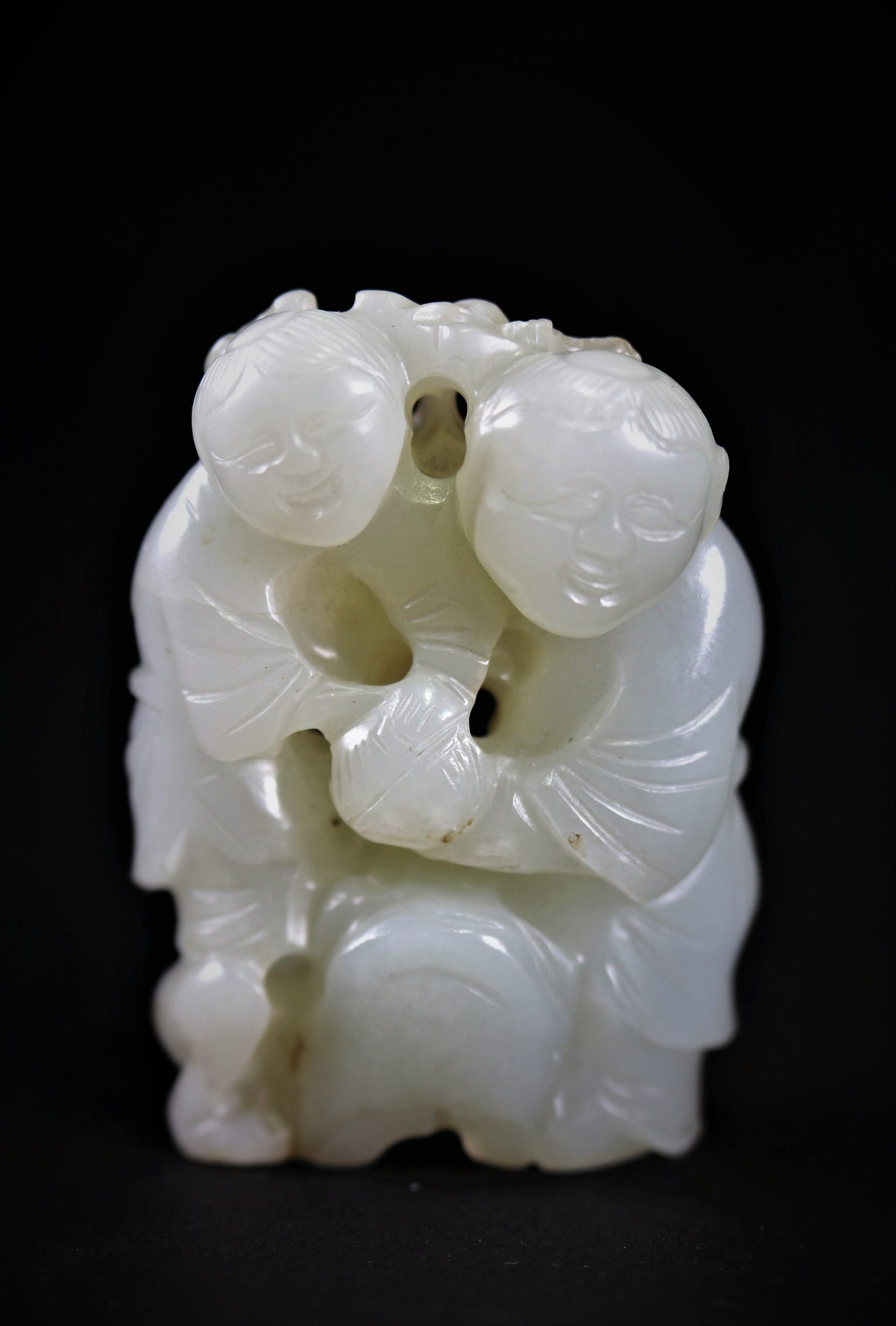
Chinese White Jade HeHe Boy Carving – 17th Century 白玉和合二仙玉珮
A beautiful Chinese white jade carving of HeHe boys from the 18th century Qing dynasty. He-He Er Xian (和合二仙) translated as the Immortals of Harmony and Union and as the Two gods of Harmony and Union, are two Taoist immortals. They are popularly associated with good friendship and happy marriages.
Size: 2-1/8″ H
Condition: Good condition, no damage found.
清18世纪白玉和合二仙珮

